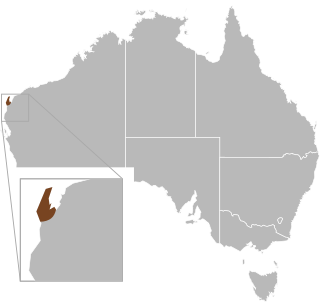
Pygopodidae, commonly known as legless lizards, snake-lizards, or flap-footed lizards, is a family of squamates with reduced or absent limbs, and are a type of gecko. At least 35 species are placed in two subfamilies and eight genera. They have unusually long, slender bodies, giving them a strong resemblance to snakes. Like snakes and most geckos, they have no eyelids, but unlike snakes, they have external ear holes and flat, unforked tongues. They are native to Australia and New Guinea.

Delma is a genus of lizards in the family Pygopodidae. The genus Delma contains 22 valid described species, all of which are endemic to Australia.

John Edward Gray, FRS was a British zoologist. He was the elder brother of zoologist George Robert Gray and son of the pharmacologist and botanist Samuel Frederick Gray (1766–1828). The standard author abbreviation J.E.Gray is used to indicate this person as the author when citing a botanical name. The same is used for a zoological name.

The Northland green gecko, also known commonly as Gray's tree gecko is a species of lizard in the family Gekkonidae. The species is found only in the Northland region of New Zealand, north of Whangaroa; it is one of the rarest and most highly sought after lizards.

Gekko smithii, commonly known as Smith's green-eyed gecko or the large forest gecko, is a species of lizard in the family Gekkonidae. The species is native to mainland Southeast Asia and Indonesia.

The serrated hinged terrapin is a species of turtle in the family Pelomedusidae. The species is native to East Africa and Southern Africa. There are two recognised subspecies.

Delma molleri is a small [the snout-vent length of the largest specimen measured 111 mm (4.4 in)], limbless lizard found in southern South Australia around the Adelaide Hills, and pretty common in Adelaide suburbs. Delma molleri has been recorded from a variety of habitats ranging from grassland to woodland beneath rocks, timber, and rubbish. The species is oviparous.

Microlophus grayii, also commonly known as the Floreana lava lizard, Gray's lava lizard, and Gray's Pacific iguana, is a species of lava lizard in the family Tropiduridae. The species is endemic to the Galapagos island of Floreana.

Wahlberg's velvet gecko is a species of large gecko, a lizard in the family Gekkonidae. The species occurs exclusively in Southern Africa.
Amplorhinus multimaculatus, commonly known as the many-spotted snake or the Cape reed snake, is a species of mildly venomous snake in the family Pseudoxyrhophiidae. The species, which is native to southern Africa, is monotypic in the genus Amplorhinus.

Delma butleri, also known commonly as Butler's legless lizard, Butler's scalyfoot, the spinifex snake-lizard, and the unbanded delma, is a species of lizard in the family Pygopodidae. The species is endemic to Australia.

Fraser's delma, also known commonly as Fraser's scalyfoot, is a species of lizard in the family Pygopodidae. The species is endemic to the state of Western Australia.

The patternless delma is a species of legless gecko from the Pygopodidae family. This species is commonly found throughout New South Wales, Queensland and southeastern South Australia, mostly inhabiting areas consisting of dry to temperate southern grasslands and grassy woodlands.

The North West Cape delma, also known commonly as Teale's delma, is a species of lizard in the family Pygopodidae. The species is endemic to Western Australia.

The excitable delma is a species of lizard in the Pygopodidae family endemic to Australia. The lizard gets its name from its active and jumpy defense mechanism. It will erratically jump multiple times in succession, each jump pivoting its body in a different direction. D. tincta is a slender, long legless lizard that through evolution lost its limbs. It is found throughout Australia in a variety of habitats, and spends most of its time hiding. Due to its nocturnal nature, it is rare to spot in the wild. This legless lizard is small to moderate in size, with a tail that is three to four times its body length. The typical size of the excitable delma is 250 – 300 mm. This lizard is an insectivore and feeds on insects it finds when travelling through grass, logs, surface soil, and loose rocks. Like all pygopodids, the excitable delma is oviparous and only lays two eggs per clutch.

The Zuytdorp worm-lizard, also known commonly as Smith's legless lizard, is a species of lizard in the family Pygopodidae. The species is endemic to Australia.
Monopeltis capensis, also known commonly as the Cape spade-snouted worm lizard, the Cape wedge-snouted worm lizard, the Cape worm lizard, and the South African shield-snouted amphisbaenian, is a species of amphisbaenian in the family Amphisbaenidae. The species is native to southern Africa.

Pedioplanis laticeps, known commonly as the Cape sand lizard or the Karoo sand lizard, is a species of lizard in the family Lacertidae. The species is endemic to Southern Africa.

Panaspis wahlbergii, also known commonly as the Angolan snake-eyed skink, the savannah lidless skink, and Wahlberg's snake-eyed skink, is a species of lizard in the family Scincidae. The species is widely distributed in Sub-Saharan Africa. However, it likely represents more than one species.

Lophognathus gilberti, also known commonly as Gilbert's dragon and Gilbert's lashtail, is a species of lizard in the family Agamidae. The species is endemic to Australia.



















